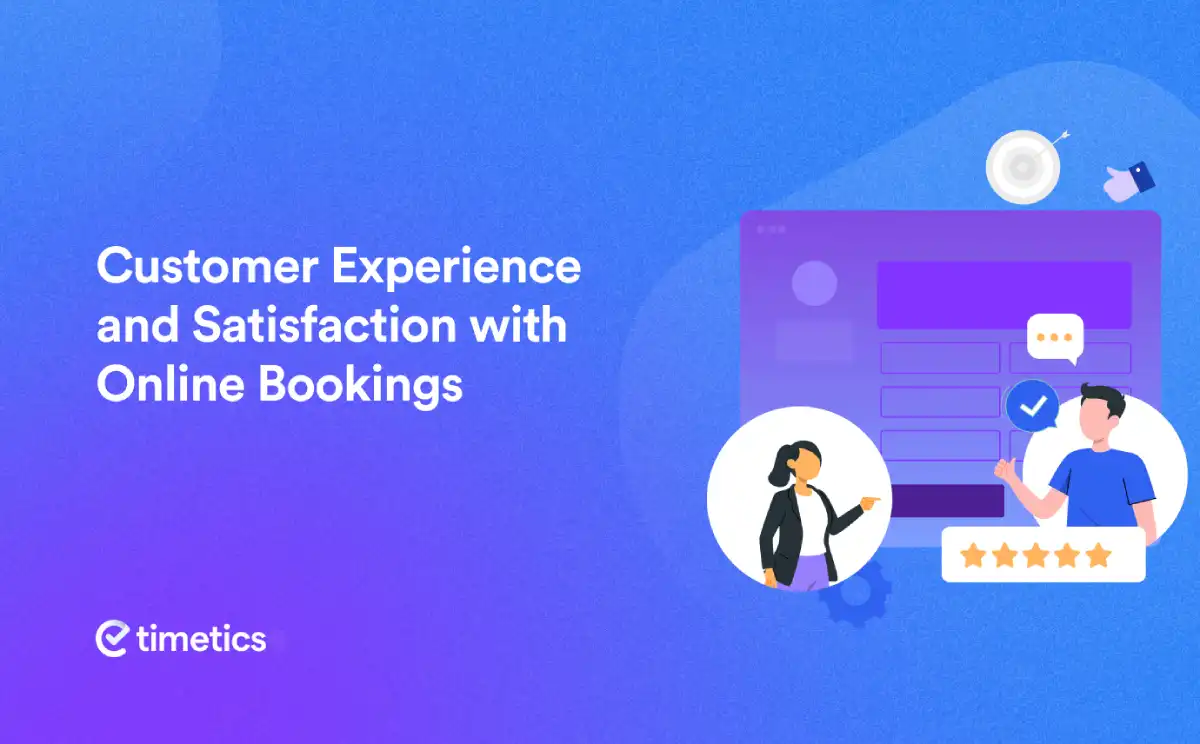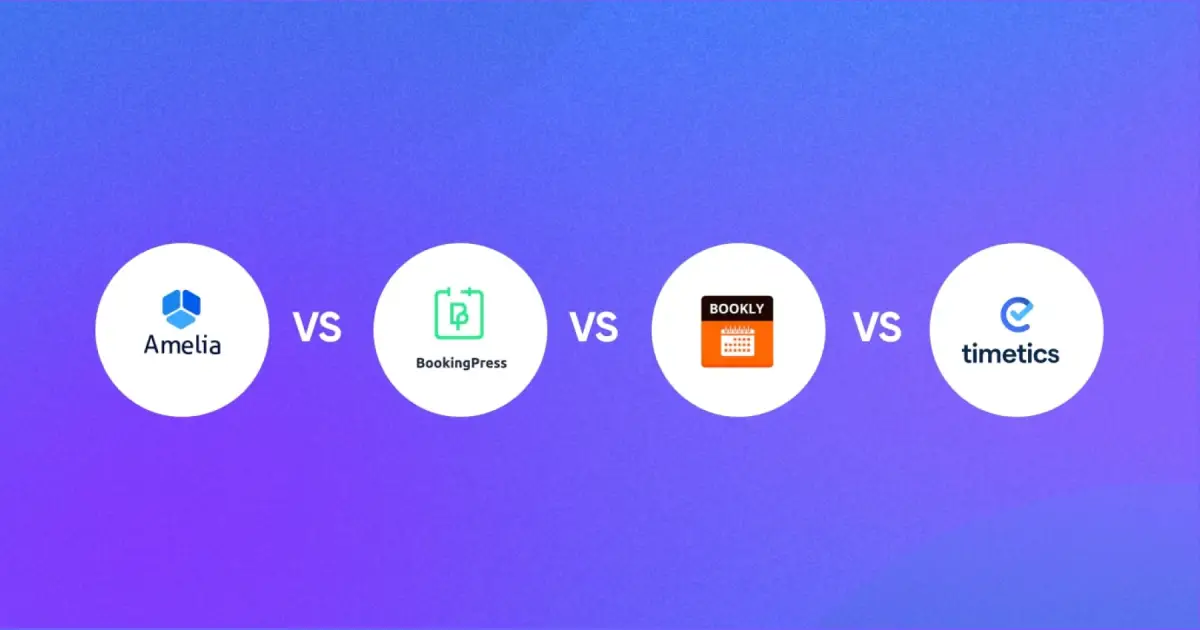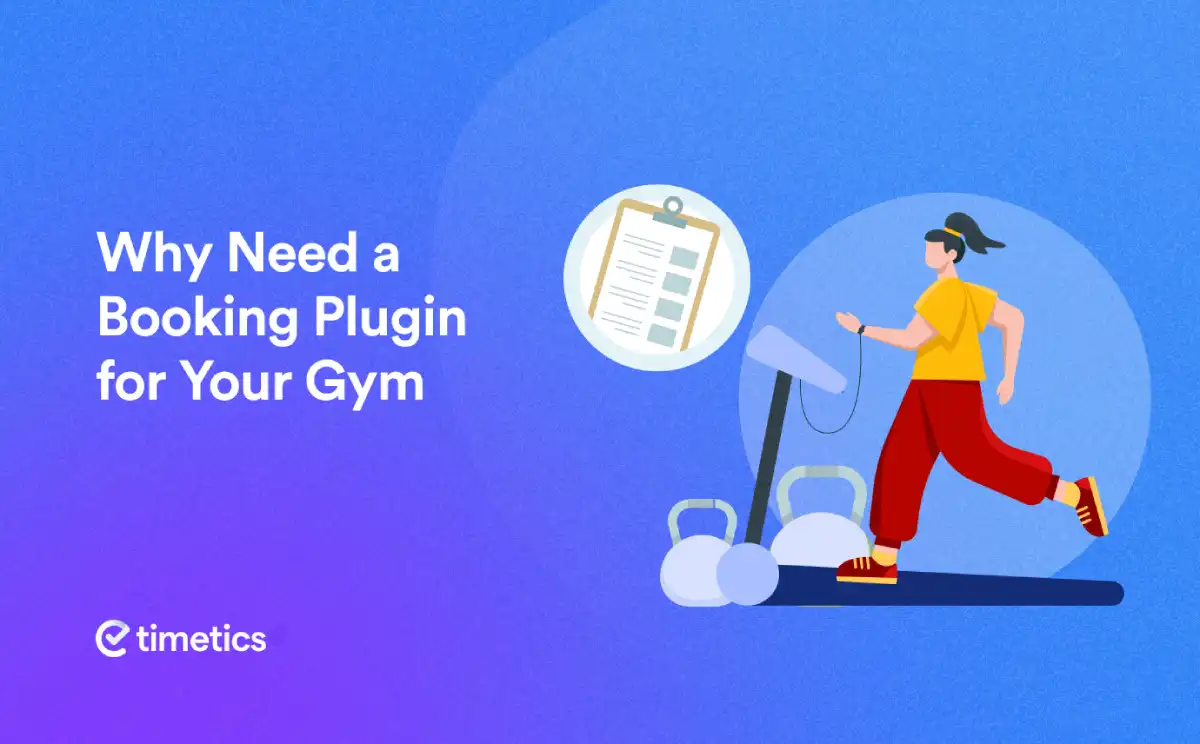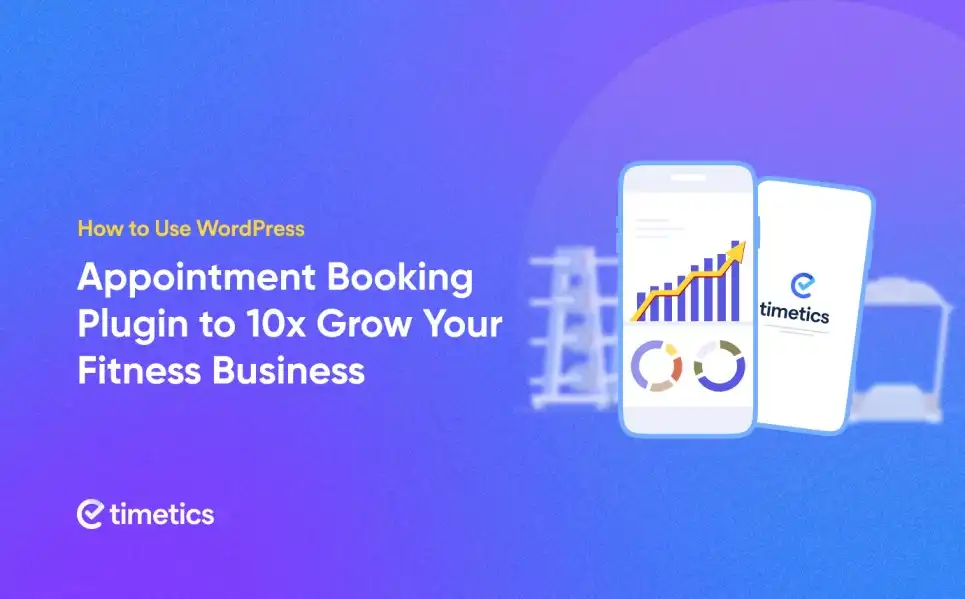6 Proven Ways to Improve Customer Experience through Online Booking

Did you ever face this?
A potential client lands on your website, ready to book your service. They click “Book Now”, wait a few seconds, and… boom, confusion hits. Too many steps. Too many fields. No clear confirmation.
So what do they do? They bounce.
That single lost booking could’ve been your next loyal customer, but poor user experience (UX) let them go away.
A smooth booking flow builds trust, saves time, and keeps clients coming back. A clunky one? It costs you sales, credibility, and repeat customers.
Nowadays, customer experience isn’t just about what you sell; it’s about how easy and enjoyable it is for people to interact with your business.
That’s why in this guide, you’ll learn 6 proven ways to improve customer experience using online booking systems — plus a few bonus tips that’ll make your clients love booking with you again and again.
Let’s dive in.
What is customer experience and satisfaction?
Customer experience refers to the way customers experience a company’s products and services.
In short, when a customer uses your products or services and finds the overall journey very helpful, supportive, problem-solving, and very inviting to come again, that’s when a good customer experience takes place.
By contrast, if a client doesn’t get the treatment as expected during their time with your product or service, they appear to have a bad customer experience, which leads to customer dissatisfaction.
Why does customer experience matter in online bookings?
Let’s start with the basics.
Customer experience (CX) is how people feel when they interact with your business from the moment they visit your website to the second they complete a booking (and beyond).
If every step feels smooth, helpful, and frustration-free, that’s good customer experience.
If they struggle to find information or can’t finish a booking easily, that’s bad experience and it kills trust instantly.
Now, customer satisfaction is what happens after that experience. It’s the emotional result how happy or disappointed someone feels after dealing with your brand.
In short:
💡 Great experience = Happy customers = Long-term satisfaction.
That’s why every successful service business, from salons and fitness studios to consultants and event planners, focuses on creating a frictionless booking journey. Because when your customers enjoy the process, they don’t just come back… they bring others with them.
When your booking flow feels easy and intuitive, it also strengthens your brand perception. You can learn how design impacts conversions in our guide on creating event landing pages that convert
6 proven ways to improve customer experience with online booking systems
So now that you understand why customer experience matters, let’s talk about how actually to improve it.
The good news? You don’t need to rebuild your website or hire a customer experience consultant to make clients happy.
With a few smart tweaks and the right online booking system, you can make the entire journey frictionless, fast, and surprisingly fun.
Here are six proven ways to make your booking experience so good that customers keep coming back for more
Step 1: Use an Online Booking Tool
Here’s where most businesses mess up: they treat booking like a side feature instead of a key part of the customer journey.
A great booking plugin doesn’t just collect appointments it creates trust. When your booking page looks clean, loads fast, and feels easy to use, customers immediately feel confident in your brand.
If you’re using WordPress, installing a dedicated booking plugin is your best move. It saves hours of manual work, ensures a professional experience, and even lets you automate confirmations and reminders.
Pro tip for success: Avoid DIY booking forms they often break or confuse visitors. Go for a plugin built specifically for user experience.
Some of the best options include:
- WP Timetics – Perfect for freelancers, consultants, and small teams who want simple one-step scheduling.
- Booktics – A powerful solution for service-based businesses that need multi-step booking flows, analytics, and automation.
- Timetics AI – Great cloud-based options if you’re not using WordPress.
Once you integrate one of these tools, your visitors can instantly book appointments without back-and-forth emails giving them the smooth, modern experience they expect.
To explore how online booking can help different business types, check out our post on appointment booking plugins for fitness businesses
Step 2: Simplify the booking process
Here’s a golden rule: If your booking feels complicated, your customers won’t complete it.
Most users make up their minds in seconds. If they see too many fields, confusing buttons, or unclear next steps, they’ll leave and you’ll lose the sale.
That’s why simplicity is your best conversion strategy.
A streamlined booking process helps customers move from “I want this” → “I’ve booked it” without overthinking.
Here’s how you can make that happen:
- Keep it short and clear: Only ask for the information you actually need name, email, service, and time. Extra questions can always come later.
- Use a progress indicator: If your form takes more than one step, show users where they are in the process. Progress bars boost completion rates by up to 30%.
- Add inline validation: Let users know if they’ve entered something wrong before submission. No one likes surprise error messages after hitting “Book Now.”
- Offer instant confirmation: As soon as a booking is made, show a clear success message or send an auto email. It removes doubt and builds instant trust.
Pro tip for success: Fewer clicks = higher conversions. Test your booking page on mobile if you can’t book in under 60 seconds, it’s time to simplify.
When booking feels effortless, users don’t just finish the form, they remember the experience. That memory is what builds repeat business and word-of-mouth growth.
Want to make your booking pages even more engaging? Learn how to create a high-converting event landing page in WordPress.
Step 03: Offer flexibility and choice
Want to know the fastest way to turn a good booking experience into a great one?
Give your customers control.
When people can choose when, how, and with whom they book they instantly feel valued. That sense of flexibility builds trust and loyalty faster than any marketing campaign ever could.
Think about it: life doesn’t always run on business hours. If someone wants to book your service at midnight or pick a specific team member, your booking system should say, “Sure thing!”
Here’s how flexibility enhances the overall customer experience:
- Multiple Appointment Types: Whether you offer consultations, private sessions, or group classes let users choose what fits them best.
For example, WP Timetics supports one-to-one and one-to-many sessions, so you can easily handle solo meetings, group events, or even webinars.
- 24/7 Booking Availability: Customers shouldn’t have to wait for office hours. Let them book anytime morning, midnight, or weekend. Tools like Booktics keep your calendar open and synced even while you sleep.
- Staff or Host Selection: If you run a business with multiple service providers, let customers choose who they want to work with. This simple choice makes the experience feel personal and customers love that.
- Reschedule Freedom: Life happens. Allow clients to reschedule without friction. It shows you respect their time and builds long-term trust.
💡 Pro Tip:
Flexibility = freedom. And freedom = satisfaction. The easier it is for customers to control their booking, the more likely they are to complete and repeat it.
With these small touches, your online booking system stops feeling like a transaction and starts feeling like a conversation.
Want to make your booking flow even more professional? Check out our guide on how to integrate CRM in your WordPress website — it helps personalize every client interaction based on their booking behavior.
Step 04: Automate communication and reminders
Let’s be honest, no matter how great your service is, people forget things. Life gets busy, inboxes overflow, and appointments slip through the cracks.
That’s where automation becomes your silent hero.
When your booking system automatically sends confirmations, reminders, and follow-up emails, it not only saves you hours it also creates a smoother, more trustworthy customer experience.
Here’s how automation transforms your booking journey 👇
- Instant booking confirmation
The moment someone schedules a session, send a personalized confirmation email. It reassures the customer that their booking went through successfully no second-guessing.
You can even use tools like WP Timetics to send branded confirmation messages automatically, improving both UX and professionalism.
- Automated Reminders (Email + SMS)
A gentle automated reminder can cut no-shows by more than 40%. Your system should send alerts 24 hours and 1 hour before the meeting — via both email and SMS.
Check out this detailed guide on how to automate appointment reminders in WordPress it walks you through SMS setup, email triggers, and integration options.
- Follow-Up Emails After Meetings
Once a meeting is done, send a short thank-you email and ask for feedback. A simple “How was your experience?” builds loyalty and helps you improve over time. You can also personalize follow-ups with templates like those from our appointment email templates collection.
- Integrate Smart Tools Like Twilio or Google Calendar
When you connect your booking system with Twilio, you can deliver real-time text reminders that customers actually read.
To make it seamless, follow our step-by-step tutorial on integrating WP Timetics with Google Calendar.
This syncs bookings, reminders, and calendar events ensuring no one ever misses an appointment again.
With automated reminders, confirmations, and follow-ups in place, your booking system stops being reactive and starts feeling proactive. It’s the kind of experience that turns a one-time client into a lifelong fan.
Step 5: Gather and act on customer feedback
Here’s the thing most businesses forget: Customer experience doesn’t end when the booking is confirmed it starts there.
The smartest brands use feedback as their secret growth engine. Why? Because every response, rating, or suggestion tells you exactly what to improve next.
When you collect feedback strategically, you don’t just fix problems you build stronger relationships.
Here’s how to make it part of your booking journey 👇
- Send quick post-booking surveys
After every meeting or appointment, send a short survey asking about the experience.
You can automate this inside your booking flow no manual follow-ups needed.
We’ve seen tools like Booktics or WP Timetics make this super simple with built-in feedback forms.
- Add ratings or comments to confirmation pages
Instead of redirecting users to a blank “Thank You” screen, let them leave a quick 1–5 star rating or drop a comment right there.
This keeps engagement high and helps you capture insights instantly — before they forget.
- Integrate feedback with CRM tools
If you’re using CRM or automation plugins, you can centralize all customer feedback for easier analysis.
Learn how to connect your booking data with CRM tools in our guide on how to integrate CRM in your WordPress website.
Once integrated, you’ll see patterns like which time slots get the most complaints or which staff members earn the best reviews.
- Analyze and Take Action Fast
It’s not enough to collect feedback you have to act on it. Review patterns weekly and adjust your booking process, reminders, or staff assignments accordingly.
If you’re noticing repeat complaints about booking speed or interface, check out our post on digital booking solution red flags to spot and fix the real cause.
When customers see that you actually listen and improve, they’ll trust you more, book faster, and recommend you naturally. That’s what turns a regular booking system into a relationship builder.
Step 6: Provide extraordinary customer support
Even the best online booking system can’t cover every scenario. There will always be moments when a customer has a question, a technical issue, or just needs a bit of reassurance.
And that’s where great customer support becomes your ultimate advantage.
When users know help is one click away, their confidence in your brand skyrockets, and that feeling often turns a casual buyer into a loyal fan.
Here’s how to make your support experience stand out:
- Create a dedicated booking support page
Add a simple “Need Help?” section right inside your booking page. You can embed a quick support form or let users schedule one-on-one help sessions.
For example, use WP Timetics to create a short “support appointment form” that automatically assigns available team members.
Want to learn how to do this? Here’s a guide on how to schedule a meeting with WP Timetics.
- Use automated FAQs for common questions
Most people just want quick answers like “Can I reschedule my appointment?” or “Do you send reminders?”
Instead of making them dig through pages, add these questions directly inside your booking form or on a help sidebar.
If you’re offering time-based services, our tutorial on how to reschedule an appointment is an excellent example of how to make that process smooth and frustration-free.
- Offer multi-channel support (Chat, Email, or Ticket)
Don’t lock your users into a single communication channel. Some people prefer chat, others email, and some might want a callback. With modern tools, you can manage all of these channels from one dashboard.
To make it work seamlessly, connect your booking plugin to automation tools we explained the process in How to automate appointment reminders in WordPress.
- Respond fast and stay human
Speed matters but tone matters more. Train your team to answer quickly and politely.
Even if you can’t fix something instantly, acknowledging it builds trust.
Our post on appointment scheduling mistakes and solutions outlines how proactive communication can prevent frustration before it happens.
In the end, excellent support isn’t a cost it’s your best marketing channel. A single positive interaction can create a loyal customer who not only returns but also recommends your business to everyone they know.
Pro tips to keep your customers satisfied and keep Them Coming Back
Now that you’ve built a smoother, smarter booking experience — let’s take it one step further.
Because the real growth doesn’t just come from new customers… it comes from keeping the existing ones happy.
That’s where retention, personalization, and brand consistency make all the difference.
Here are a few advanced tips to keep your clients coming back again and again 👇
1. Personalize Every Interaction
Use booking data to tailor the experience: greet customers by name in confirmations, suggest time slots based on history, and recommend related services automatically. Start with AI-driven workflows in WP Timetics, and learn practical setups from how to use AI in WordPress.
2. Use Chatbots & Live Chat for Instant Support
Customers shouldn’t wait for email replies. Add a live chat widget or a smart chatbot to handle quick questions—reschedules, confirmations, or payments. Reduce no-shows with best practices from the best ways to confirm meetings.
3. Keep Branding Consistent Across Touchpoints
Make your booking page, confirmation emails, and reminders feel like one brand: same colors, tone, and UI patterns. If you’re building the flow on WordPress, follow the design best practices in create a booking website with WordPress.
4. Reward Loyal Customers
Offer perks for repeat clients—exclusive discounts, early access to premium time slots, or member-only add-ons. Promote offers with on-site popups right after a booking using tools covered in best popup builder for WordPress.
5. Keep Evolving with Customer Data
Track drop-offs, sold-out slots, and repeat behaviors. If a step causes friction, simplify it. For strategic tuning, review why consider a fitness booking plugin and digital booking solution red flags to avoid hidden UX pitfalls.
🚀 Next step: Turn these tips into action with automated confirmations, reminders, and follow-ups. Start with automated appointment reminders in WordPress, then personalize flows via WP Timetics.
Frequently asked questions
-
How can I make my online booking process more user-friendly?
Keep it short, clean, and mobile-ready. Use clear labels, auto-fill options, and instant confirmations so users can book in under 60 seconds.
-
Which WordPress plugin is best for improving customer experience?
Tools like WP Timetics and Booktics offer modern interfaces, automated reminders, and flexible scheduling — everything you need for a smooth booking flow.
-
How do automated reminders improve customer satisfaction?
Automated emails and SMS reduce no-shows and show professionalism. Learn to set them up easily with this guide on automating appointment reminders in WordPress.
-
Why is customer feedback important for online booking systems?
Feedback reveals usability gaps and helps you refine the process. Use post-booking surveys and analytics to enhance customer experience and retention continuously.
-
What’s the easiest way to reduce booking errors or missed appointments?
Sync your calendar with tools like Google Calendar integration and automate confirmation alerts. It keeps schedules accurate and prevents confusion for both you and your customers.
Conclusion
At the end of the day, a booking system isn’t just about scheduling — it’s about experience.
Every click, confirmation, and follow-up shapes how customers feel about your brand.
When that experience is smooth, simple, and personal, people don’t just complete their bookings — they come back again and tell others about it.
By using the right tools, automating your communication, and acting on feedback, you can create a customer journey that feels effortless on the outside but powerful behind the scenes.
The best customer experience isn’t built overnight — it’s built one great booking at a time.
So, start small, simplify your booking flow, and let automation handle the rest.
🚀 Ready to give your customers a better booking experience?
Try Booktics — the all-in-one WordPress booking plugin built for service-based businesses. Automate confirmations, reminders, and follow-ups — all in one clean, simple dashboard.
Get Started with Booktics →


